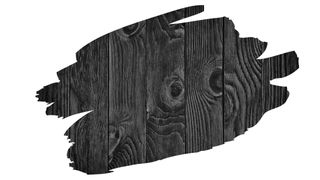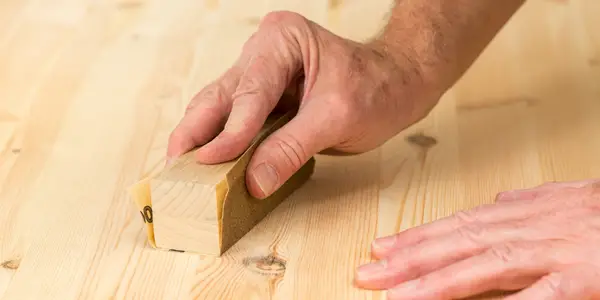Applying wood finishes can at times be fairly tricky.
Between sanding, multiple coats, and all of that waiting around; finishing can feel like more of an art than a science. Yet it’s the little things — such as popping the grain — that can help finishes go on much smoother.
But, do you always need to raise the grain before you apply an oil finish?
Well, in this post, we explain why wood can feel so rough after you apply water-based wood finishes onto it. You’ll also learn why even certain oil-based coats can cause this issue as well.
And keep reading to discover a simple way to pop the grain in preparation for that final coat.

This post may contain affiliate links to products that we receive a commission for (at no additional cost to you). Learn more here.
What Do You Mean By Raising The Grain? What Does Raising The Grain Do?
Raising the grain, (sometimes referred to as popping the grain), is a key step in preparing wood for a finishing coat.
Wood finishes, (particularly water-based ones), can become quickly absorbed by wood fibers. And once that happens, those fibers will swell and ‘pop’ up.
This, in turn, means that your finishing coat — after it’s dried and cured — can feel very rough.
So, to avoid all of this from happening in the first place, we raise the grain beforehand. That way any wood fibers that are likely to swell, will do so before we start to coat them.
But Should You Raise The Grain Before Applying Finish Or Stain?
It mostly depends on the type of finish you plan on applying.
You see, wood grain will pop when it absorbs water. However, it doesn’t readily absorb oils or solvents in the same way.
So, if you have a water-based finish, then you’ll almost certainly need to pop the grain. Otherwise, with oil-based finishes, you may not need to.
But Do You Really Need To Do This For Oil Finishes? Does Oil-Based Primer Raise Wood Grain?
Wood doesn’t suck up oils the way it does with water. So, oils do not cause wood grain to pop.
However plenty of modified oil finishes, (such as water-based oil-modified polyurethane), contain a certain amount of water. And, in those cases, their water content will cause wood grain to rise.
Related Post: Can You Use Polyurethane On Tree Bark Decorations?
OK. But Is Grain Raising Something I Need To Be Concerned About?
If you want a smooth finish, then yes it is. But, if you want a more textured surface — one that feels more like natural wood — then no you don’t.
What’s more, if you’re applying multiple coats of say a polyurethane finish, you’ll likely be sanding in-between each coat anyway.
So, while a water-based polyurethane will raise the grain, sanding between each subsequent coat will smooth things out. Nevertheless, doing things this way means that you’ll need to put in a lot more effort into sanding between coats.
You see, when you sand between coats, you’re looking to create a bit of grit for the next coat of poly to stick to. You’re not trying to get that surface smooth again.
However, that is precisely what you’ll need to do if the grain pops up after a water-based poly is applied.
Will Rubbing Alcohol Raise The Grain Of Wood? Isopropyl alcohol, (aka Rubbing Alcohol), is 30% water. And due to its significant water content, rubbing alcohol can raise the grain of wood. But, distilled water will do a better job at popping those fibers.
Got It. So How Do I Pop The Grain Before Finishing Or Staining Wood?
The simplest way to do this is to spray the surface of wood with water.
Ideally use distilled water, especially if you are working with woods that are notorious for ‘bleeding’ color, such as Padauk. Distilled water is specially purified water, so it won’t contain any chemicals or solvents that can leave behind a residue.
Related Post: Why Do Mineral Spirits Sometimes Leave Behind A Residue? (Revealed!)
Once you’ve got some distilled water to hand, you can raise wood grain by doing the following;
1). Fill a spray bottle with distilled water, and then spritz a light spray of water all across the surface of wood. You should not drench that lumber, so keep that spray bottle at its mist setting.

2). Once done, leave that wooden surface to dry.
3). After that wooden surface appears dry, run your hand over it. It should now feel much rougher to the touch.
4). Now that you’ve raised the grain, finish off sanding with 220 grit sandpaper. And smooth down the surface, sanding off all of those roughened fibers.

5). After you’ve smoothed the surface, you can get to work with your chosen wood finish or stain.
To Wrap Up, Here Are The 3 Key Takeaways From This Post…
- 1). If you apply a water-based finish onto a wooden surface, the fibers in wood will absorb the water in that finish. This causes those fibers to swell, roughening up the surface.
- 2). Raising the grain is a key step to preparing wood for any water-based finishes (and some oil-based water-modified ones too). By raising the grain, you can prevent wood from feeling rough to the touch after finishing.
- 3). Spray the surface of wood with a light mist of water. This will raise the grain, allowing you to sand off any fine wood fibers that pop up.



